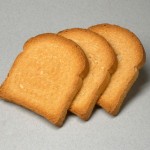by Cat, Sept 2007 (photo, right, from Wikimedia Commons)
Called skorpor in Denmark and zwieback in Germany, rusk is used throughout western Europe mainly as a breakfast item: dipped into coffee, or broken into a bowl and eaten as a cereal with warm milk and butter. Another use is as a baby teething food. It can also be used to make a delicious crumb crust, as in my recipe for Æblekage (Danish Apple Cake).
Rusk is an excellent keeper (provided you dry it thoroughly after baking); make batches in the winter when you like the warmth of your oven, and store for use on hot summer days.
- Includes: 1. Basic Rusk (yeast-risen); 2. Quick Almond Rusk (Mandelskorpor)
- See also: 1. Æblekage; 2. Biscotti; 3. Spelt vs Wheat in Baked Goods & Pasta
 My first recipe is a yeast-risen bread, baked twice; I would love to adapt this to sourdough (once my sensitivity to sourdough is balanced). The second recipe is for almond rusks, which resemble Italian biscotti, and is made not with yeast, but rather baking powder as leavening.
My first recipe is a yeast-risen bread, baked twice; I would love to adapt this to sourdough (once my sensitivity to sourdough is balanced). The second recipe is for almond rusks, which resemble Italian biscotti, and is made not with yeast, but rather baking powder as leavening.
 Note that Nabisco brand Zweiback (photo, above-left, from Amazon) is no longer available. However, as of Oct 2022, Amazon has a German band: Brandt’s Zwieback-Rusk or Brandt’s Der Markenzwieback; photo, right, is also from Amazon, ASIN B01ASVY8A8) that comes in 8-oz boxes.
Note that Nabisco brand Zweiback (photo, above-left, from Amazon) is no longer available. However, as of Oct 2022, Amazon has a German band: Brandt’s Zwieback-Rusk or Brandt’s Der Markenzwieback; photo, right, is also from Amazon, ASIN B01ASVY8A8) that comes in 8-oz boxes.
If you have a recipe that calls for a ‘packet of Zweiback,’ how much would that be?
- I have an old box of Nabisco Zweiback containing 2 fresh packs for total weight of 6 oz (170 grams); is a ‘packet’ then a 3 oz size? or the 6 oz box?
- A German brand – Brandt – comes in 8 oz boxes (227 grams) containing two 4-oz packets.
- A Zweiback Cheesecake recipe on allrecipes.com (5) refers to a 4 oz package of zweiback.
- A comment to a Zwieback recipe on King Arthur Flour (6) uses 4 oz zwieback crumbs and ½ cup ground walnuts for the crust of a 9″ cheesecake.
I’m inclined to use 4 oz of zwieback or rusk crumbs.
Basic Rusk Recipe
This recipe, adapted from Wonderful Wonderful Danish Cooking by Ingeborg Dahl Jensen (1), makes one 4″ x 8″ loaf. I use whole hard white winter wheat flour (such as Wheat Montana’s Prairie Gold, and organic unbleached white flour (see Wheat (about), for more info). How do you know when it has risen enough (doubled in size):
- Finger test for rise in bowl: Poke it with 2 fingers (apart), about ½” deep; if it holds the indent, it’s ready (per BonAppetit (2), Choosing Voluntary Simplicity (3), or if it mostly holds the indent but springs back a little, per The Fresh Loaf (4).
- Finger test in pan: With one finger, make a SMALL dent in the dough near the side of the pan. If dent remains it is ready to bake, from Choosing Voluntary Simplicity (3)
I made a loaf in Dec 2008, and used half for my annual Æblekage on Christmas Eve. The other half I put into a plastic bread bag to store in a darker corner of my kitchen counter, planning to eat it one slice at a time at breakfast. However, it sat uneaten the entire year, and was still good for my Christmas 2009 Æblekaga.
Ingredients and Equipment:
- ½ – 1 T dry yeast
- 2 Tbsp Rapadura sugar
- 2 Tbsp lukewarm water
- 1 cup milk
- 2 Tbsp butter
- ½ tsp unrefined sea salt
- 1 fresh organic cage-free egg, beaten
- 1 ½ cup whole wheat or spelt* flour
- 1 – 1 ½ cups unbleached white flour
- small amount olive oil or melted butter
- large bowl
- cotton dish towel
- 4″ x 8″ loaf pan
- cookie sheet
* If using spelt, it requires less moisture for equivalent amount of flour than wheat. Adjust texture by increasing amount of spelt flour or by reducing amount of liquid in the recipe. Spelt also works up (achieves optimum rise) faster than wheat.
Procedure:
- Butter a loaf pan.
- Measure water into 1 cup measure; add half the sugar and sprinkle dry yeast over. Let sit until yeast begins to foam.
- Meanwhile, scald milk (place over medium heat until steam begins to rise from the milk, but does not yet boil). Remove from heat and add butter, remaining half of sugar and salt. Allow to cool to point where you cannot feel its warmth on the the back of your wrist.
- Add yeast mixture, egg, and whole wheat pastry flour.
- Mix thoroughly, and then beat with a wooden spoon for 100 strokes to work the gluten.
- Add unbleached flour in increments, until you can no longer stir the dough.
- Flour a board or counter with unbleached flour, turn dough onto floured surface, and knead in as much of the remaining flour as it takes to keep it from sticking, yet light and elastic. Shape into a round.
- Wipe out the bowl, and then rub a little olive oil or melted butter around the inside of the bowl. Add round of dough to bowl. Cover with a damp cotton dish towel (or place bowl in moistened plastic bag), and let rise in a warm place until double in bulk (Two finger test; see above. Remember that this happens faster for spelt than for wheat).
- Preheat oven to 450°F.
- Knead the dough again on floured surface. Shape into an oblong loaf: Flatten dough with hand, then roll up tightly. Place into buttered loaf pan, cover with the damp cotton cloth (or place pan in moistened plastic bag), and let rise again in a draft-free warm spot until doubled in bulk.
- Bake in preheated 450°F oven for 10 minutes. Then lower heat to 350°F and bake an additional 40 minutes.
- Remove bread from oven and allow to cool. Turn off oven.
- Slice loaf in 1″ thick slices, lay on a cookie sheet, and return to the warm oven to dry thoroughly.
Testing
Testing 2008: Tested using whole and unbleached white wheat flour, as written. Excellent flavor, and kept well over a year from Christmas-time 2008 to Christmas-time 2009.
Testing 102612: Used whole and unbleached white spelt flour for this test. Spelt requires less moisture for a given amount of flour than does wheat. Used 1 ½ c whole spelt and about 1 ¼ cup white spelt before first rise, and another 2 Tbsp white spelt when shaped loaf. First rise was about 50 minutes (I tested by pressing 2 fingers into dough; the depressions did not fill in, indicating doubling in bulk). Second rise about 1 hour – way faster than I expected. Bread has wonderful flavor and crumb, but it tends to fall apart just below the top crust on one side. Sliced 10 slices plus 1 heel that I ate; into warm (but off) oven to dry.
Testing 120512: Wanted to make this with less sugar for sandwich bread – no drying in oven after baking. So made as written except used only 1 Tbsp sugar, total. Used 1 ½ cups whole spelt to beat 100 strokes, then added ½ cup unbleached white flour (wheat) and another ½ cup during kneading & shaping, total 1 cup white flour. This definitely is a lively mix! Set to first rise at 10:05 AM; had doubled (2-finger test) at 10:50 – only 45 minutes. Shaped into loaf, placed in buttered pan and set to rise at 10:55. It had risen well above the pan at 11:35 so into the oven. Never did get to 200 F but took it out after 55 minutes total baking time (45 min at 350). Nice crumb begging to be dried to rusk. Not as sweet as the last batch, which is what I’d intended.
I think in future will use only ½ Tbsp yeast, as original rose too fast.
Basic Rusk Recipe – Soaked Flour Version
Making up a soft sponge to presoak the whole wheat flour makes the grain much more digestible, and makes its minerals more absorbable. However, I’ve found that presoaking for a yeast-rise recipe doesn’t work well, as the soaking breaks down much of the gluten, which is so important for supporting a yeast rise. Therefore I’ve decided not to adapt the recipe for a pre-soak. Instead, when I can eat sourdough again, I’ll adapt this recipe for sourdough rise.
Quick Almond Rusk Recipe (Mandelskorpor)
This is a quick-bread type recipe, using baking powder instead of yeast as leavening agent, and resembles Italian Biscotti. I’ve adapted this from Wonderful Wonderful Danish Cooking, by Ingeborg Dahl Jensen.
The original recipe did not include any liquid, but I want to adapt this recipe for a pre-soak method (works well with baking-powder leavened recipes), and that requires acidic liquid like yogurt or buttermilk. To counter the added liquid, I substitute equal amount of the flour in the recipe with coconut flour, which absorbs the liquid during baking. If you want to omit either the milk or the coconut flour, you must also omit the other, and increase the unbleached flour accordingly.
Ingredients and Equipment
- 2 eggs
- ¾ to 1 cup Rapadura sugar (or brown sugar can be used in a pinch)
- ¼ cup milk *
- 7 Tbsp soft butter, creamed
- 3 Tbsp unblanched slivered almonds
- 1 ½ cup whole wheat pastry flour
- 1 ¼ cup unbleached wheat flour *
- ¼ cup coconut flour *
- 1 tsp baking powder
- pinch unrefined sea salt
- small and large bowls
- baking sheet or jelly roll pan
* NOTE: you can omit the coconut flour, but then you must also omit the milk, and increase the unbleached flour to 1 ½ cup (or the pastry flour to 1 ¾ cup)
Method:
- Preheat oven to 375°F
- Cream butter in a small bowl.
- In a large bowl, beat eggs and sugar together until light. Add milk, creamed butter and almonds; stir to combine.
- Sift dry ingredients and add a little at a time to the egg mixture, beating well after each addition.
- Spread the dough 1 ½ inches thick on a lightly buttered baking sheet or jelly roll pan.
- Bake in preheated oven for 15 minutes.
- Remove from baking sheet and cut rusk diagonally into pieces 3/4 inch wide. Cool on a rack.
References:
- Wonderful Wonderful Danish Cooking, by Ingeborg Dahl Jensen
- Bon Appetit: bonappetit.com/tipstools/tips/2008/04/letting_yeast_dough_rise
- Choosing Voluntary Simplicity: choosingvoluntarysimplicity.com/how-do-i-tell-when-bread-dough-has-risen-enough
- The Fresh Loaf: thefreshloaf.com/node/15368/second-rise-proofing-tests
- All Recipes, Zweiback Cheesecake recipe (allrecipes.com/recipe/zweiback-cheesecake)
- King Arthur Flour recipe comment by ‘Kevin’ on 12/2/2009 (kingarthurflour.com/blog/2009/04/22/zwieback-is-dead-long-live-zwieback)

